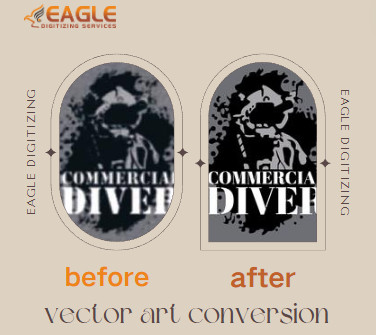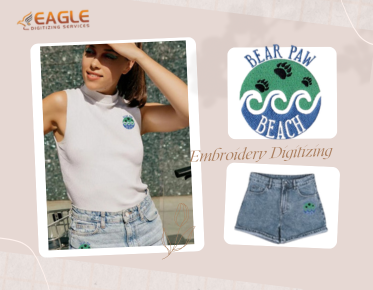Visual Revolution: Vector Art's Impact on Marketing
In the dynamic world of marketing, where capturing attention is paramount, vector art has emerged as a formidable tool. Its precision, versatility, and adaptability make it an ideal medium for conveying messages with clarity and flair. Let's delve into the transformative impact of vector art on the marketing industry and explore how it shapes branding, advertising, and digital engagement. For the first-class online vector conversion, don't hold back from contacting us.
Why Vector Art is Perfect for Marketing
Scalability: From Business Cards to Billboards
One of the standout features of vector art is its scalability. Whether it’s a tiny icon on a business card or a massive billboard advertisement, vector graphics maintain their integrity. This flexibility ensures that brands can maintain consistent visual quality across all marketing materials.
High Quality and Professionalism: The Key to Branding
First impressions matter, and high-quality visuals are essential for establishing a professional brand image. Vector art’s precision and clean lines convey a sense of sophistication and reliability, essential qualities for any successful brand.
Versatility: From Logos to Infographics
Vector art's adaptability makes it perfect for a wide range of marketing materials. Logos, infographics, illustrations, and even complex charts can all be crafted with vector graphics, ensuring uniformity and style coherence across all platforms.
The Role of Vector Art in Logo Design
Creating Memorable Brand Identities
A logo is the face of a brand, and vector art plays a pivotal role in creating distinctive and memorable logos. The ability to tweak and adjust vector designs with ease allows for meticulous refinement, ensuring that the final logo perfectly encapsulates the brand's identity.
Consistency Across Various Media
In today’s multi-platform world, maintaining consistency is crucial. Vector logos ensure that a brand's emblem looks perfect whether it's on a website, a mobile app, merchandise, or a print advertisement.
Vector Art in Advertising Campaigns
Eye-Catching Visuals for Print Ads
Print advertisements benefit immensely from vector art. The sharp, vibrant visuals can attract attention and convey messages quickly and effectively, making a lasting impression on potential customers.
Dynamic and Engaging Digital Ads
Digital advertisements are all about engagement. Vector graphics, with their smooth lines and dynamic capabilities, create visually appealing ads that can capture and hold the audience's attention in a crowded digital space.
The Power of Vector Art in Social Media Marketing
Crafting Attention-Grabbing Social Media Posts
Social media is a visual medium, and vector art excels in creating striking and shareable content. From colorful illustrations to engaging infographics, vector graphics can elevate a brand’s social media presence.
Animated Vector Art for Increased Engagement
Animation adds another layer of engagement. Animated vector art can make social media posts more dynamic and captivating, encouraging higher interaction rates and boosting brand visibility.
Enhancing Website Design with Vector Art
Sleek and Modern Website Graphics
A website’s design speaks volumes about a brand. Sleek, modern vector graphics can enhance the user experience, making websites more visually appealing and professional.
Interactive and Responsive Web Elements
Vector art is not just static; it can be interactive. Responsive vector elements adjust seamlessly to different screen sizes, providing a consistent user experience across devices.
Vector Art in Email Marketing
Designing Compelling Email Newsletters
Email marketing remains a powerful tool. Vector art can make newsletters visually engaging, improving readability and encouraging recipients to take action.
Vector Icons for Better User Experience
Vector icons can simplify complex information, making emails more user-friendly. These icons can guide readers through the content, enhancing comprehension and engagement.
Infographics: Turning Data into Art
Visualizing Complex Information
Infographics are invaluable for presenting complex data in an easily digestible format. Vector art ensures that these graphics are clear, professional, and visually appealing.
Boosting Content Shareability
Well-designed infographics are highly shareable. Vector art’s scalability and clarity ensure that infographics look great on any platform, increasing their potential reach.
Custom Illustrations: Adding a Personal Touch
Building Unique Brand Narratives
Custom illustrations can convey a brand’s story uniquely and memorably. Vector art allows for the creation of bespoke illustrations that resonate with the audience and reinforce brand identity.
Standing Out in a Crowded Market
In a saturated market, originality is key. Custom vector illustrations help brands differentiate themselves, ensuring they stand out and leave a lasting impression.
Cost-Effectiveness of Vector Art
Why Vector Art is a Smart Investment
● Scalability Without Loss of Quality
One of the most compelling reasons to invest in vector art is its scalability. A single vector file can be used for various purposes, from logos to large-scale advertisements, without any compromise in quality. This eliminates the need to create multiple versions of the same design for different formats, saving both time and resources.
● From Logos to Billboards: One File Fits All
With vector art, one file truly fits all. The same design can be seamlessly adapted for a business card or a billboard. This versatility not only ensures brand consistency but also reduces the time and cost associated with creating different versions of the same artwork.
● Reusable and Adaptable Designs
Vector art's reusable nature makes it a cost-effective choice. Once created, vector designs can be easily modified and repurposed for various projects. This adaptability means that you can quickly update designs to reflect new marketing campaigns or branding changes without starting from scratch.
● Easy Editing and Customization
Editing vector art is straightforward and efficient. Elements within a vector image can be manipulated independently, allowing for quick adjustments and customization. This flexibility reduces the time spent on revisions, further enhancing cost savings.
Cost Savings in Design Projects
● Reducing Redesign and Revision Costs
Vector art's inherent flexibility minimizes the need for extensive redesigns and revisions. Changes can be made easily, reducing the time and cost associated with each project iteration. This is particularly beneficial for clients who frequently update their marketing materials.
● Streamlining the Design Process
The efficiency of working with vector files streamlines the entire design process. Designers can work faster, and projects can be completed more quickly, leading to lower labor costs. This is a significant advantage in the fast-paced world of marketing and advertising.
Efficiency in Marketing Materials
● Consistent Branding Across Multiple Platforms
Vector art ensures consistent branding across various platforms. From digital media to print, vector images maintain their quality and appearance. This consistency is critical in developing brand recognition and trust.
● Quick Adaptation for Different Campaigns
Marketing campaigns often require quick turnaround times. Vector art's ease of editing allows for rapid adjustments to designs, enabling marketers to respond swiftly to market trends and campaign needs.
Print Media Benefits
● Perfect for High-Quality Prints
Vector art is ideal for high-quality prints. Its scalability ensures that printed materials, from brochures to posters, look sharp and professional. This high quality enhances the overall perception of your brand.
● Saving Costs on Print Adjustments
With vector art, print adjustments are minimal. Unlike raster images, which may require multiple adjustments to achieve the desired print quality, vector images print perfectly the first time. This reduces the cost associated with print proofs and adjustments.
Digital Media Advantages
● Optimized for Web and Mobile
Vector art is optimized for web and mobile platforms. Its small file size ensures quick loading times, enhancing user experience. This is particularly important for websites and mobile apps where performance is critical.
● Lower Bandwidth and Faster Load Times
Using vector images on your website can significantly reduce bandwidth usage and improve load times. This not only provides a better user experience but can also reduce hosting costs.
Trends in Vector Art for Marketing
Minimalist and Clean Designs
Minimalism continues to dominate design trends. Clean, simple vector graphics can convey messages effectively without overwhelming the audience, aligning with contemporary tastes.
Bold and Vibrant Color Schemes
Bold colors can capture attention and evoke emotions. Vibrant vector art can make marketing materials pop, creating a strong visual impact that draws in viewers.
Case Studies: Successful Vector Art Campaigns
Major Brands Utilizing Vector Art
Many major brands have harnessed the power of vector art to great effect. From Nike’s iconic swoosh to Apple’s sleek product illustrations, vector graphics have played a pivotal role in their marketing success.
Small Businesses Making a Big Impact
Small businesses, too, can leverage vector art to punch above their weight. Clever, well-designed vector graphics can help smaller brands compete with larger competitors by creating memorable and professional marketing materials.
Tools and Software for Creating Vector Art
Popular Vector Art Programs
Software like Adobe Illustrator, CorelDRAW, and Affinity Designer are industry standards for creating vector art. These programs offer robust tools and features that cater to both beginners and experienced designers.
Tips for Marketers: Choosing the Right Tool
Marketers should choose tools based on their specific needs and skill levels. While professional-grade software offers extensive capabilities, simpler tools like Inkscape can be more accessible for those new to vector art.
Hiring Professional Vector Artists
Finding the Perfect Fit for Your Brand
Hiring a professional vector artist can elevate a brand’s visual identity. It’s essential to find an artist whose style aligns with the brand’s vision and who can deliver high-quality work consistently.
Collaborating for the Best Results
Effective collaboration between marketers and artists is key. Clear communication and a shared understanding of the brand’s goals ensure that the final artwork aligns with the marketing strategy.
DIY: Creating Your Own Vector Art
Basic Tutorials for Beginners
For those interested in creating their own vector art, numerous online tutorials can help. Starting with the basics, beginners can learn to create simple yet effective designs that enhance their marketing materials.
Advanced Techniques for Marketers
Marketers with some design experience can explore advanced techniques. Mastering these skills can lead to more complex and polished vector graphics, adding a professional touch to marketing efforts.
The Future of Vector Art in Marketing
Emerging Technologies and Innovations
As technology evolves, so does vector art. Innovations such as augmented reality (AR) and virtual reality (VR) are opening new frontiers for vector graphics in marketing, offering immersive and interactive experiences.
Predictions and Expectations
The future of vector art in marketing looks promising. With ongoing advancements in software and a growing appreciation for high-quality visuals, vector art will continue to be a vital component of effective marketing strategies. Should this post have fanned the flames of your interest in vector conversion and you desire to delve deeper, don't hesitate to communicate with us.
Vector art has undeniably transformed the marketing landscape. Its versatility, scalability, and professional quality make it an indispensable tool for creating compelling and memorable marketing materials. As technology continues to evolve, vector art will undoubtedly remain at the forefront of innovative and effective marketing strategies, helping brands connect with their audiences in increasingly meaningful ways.



